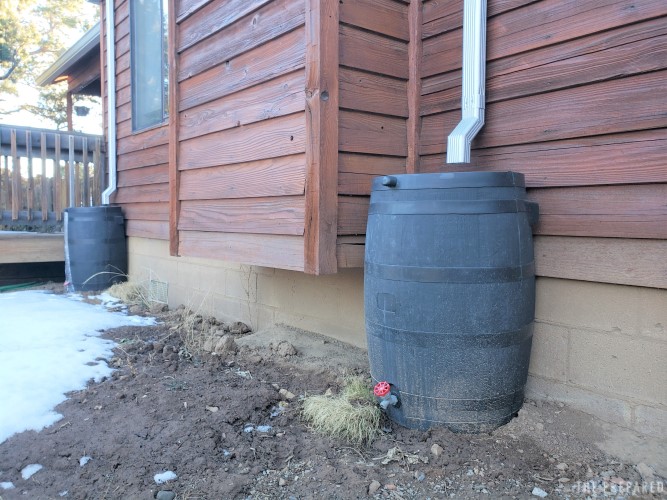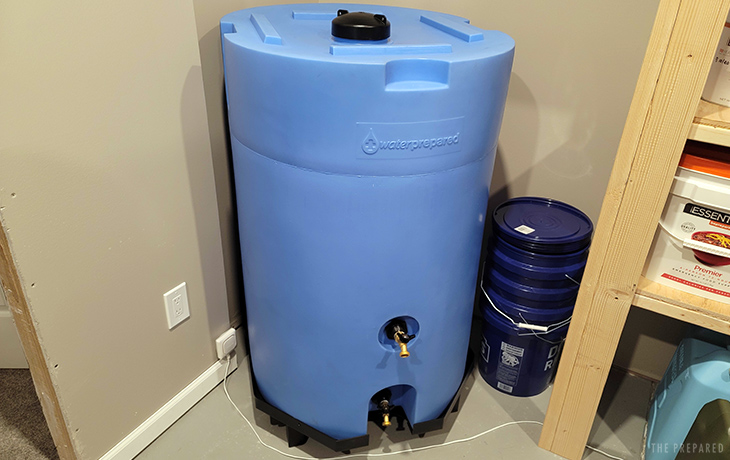If you have the space, even just a single <100-gallon tank can really level-up your prepping — knowing you have a decent amount of water on hand and ready to use goes a long way for peace of mind and handling the vast majority of potential emergencies. Water is just too critical to leave to chance, so skip the newbie mistakes such as assuming you’ll have time to ‘fill up the bathtub’ before an emergency.
Water containers are organized by their size and role:
- Personal canteens great for go-bags, everyday carry, etc.
- Smaller 5-7 gallon containers that are easier to store around the home and move by hand and foot
- These larger containers that sit in a fixed location
Even if you have the space and desire to buy the larger tanks in this review, it’s still a good idea to have a few of the 5-7 gal portable cans. Imagine you’ve got your big tank at home but now you need to go down to a local creek to collect and bring back more water, for example. Having a container that’s still small enough to carry by hand and foot when full will make those tasks a lot easier and safer.
Want to learn more about water survival? Check out The Prepared’s Water Essentials video course
The most important bits:
- The basic rule of thumb is one gallon of water per person per day. So if you have 4 people in your household and a 100-gallon container, you’ve got a little over 3 weeks worth of water (25 days).
- That 1 gal per day rule is a baseline — you’ll likely use more than 1 gal per day in long-term emergencies. (eg. the water grid problems in Flint, Michigan.)
- Water from the grid is already treated, so you don’t need to add preservation chemicals. If you use well water or something similar, add some of this or DIY with bleach.
- A quality tank will be very durable, made of food-grade plastic, be a solid color to block light (and thus algae growth), and have easy fill and drain valves.
- Water expands when it freezes, so if your tank might freeze, only fill it up about 85% to leave room for expansion.
- Since water weighs over 8 pounds per gallon, consider the weight of very large tanks and what kind of foundation you’ll put them on.
- If you store the tank outside, try to at least shade it from the sun, even if it’s just a tarp suspended a few inches above the tank. Ambient heat is less harmful than constant direct sun.
- If you plan to store inside, be mindful of any doorway and hallway widths, turns at the bottoms of staircases, etc. before buying. Some of the larger tanks are too awkward to move through a house.
- Be mindful that when the plastic tank heats up, like from sitting on hot concrete, the plastic can leach nearby chemicals and contaminate the water inside. A common example is a concrete floor with a nearby generator. The oil/gas from the generator could leak over to the tank, then be absorbed up and into the plastic. A wood or metal base in-between will solve the problem.
Below are the best large water tanks based on our staff’s personal experiences, input from the community, and an additional 12 hours of research reviewing 15+ of the top options in the market. There are water containers (“cisterns”) that hold more than 500 gallons, and we’ll update this in the future with some of those options, but the vast majority of people end up with containers <500 gallons. All of the below choices are BPA free and made from food-grade high-density polyethylene.

Smart Tank 50 Gallon Stackable water tank
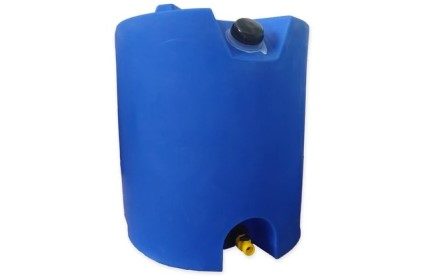
Legacy Premium 30 Gallon Stackable water tank
15-30 gallons:
50-55 gallons:
100-200 gallons:
200+ gallons:
Be prepared. Don’t be a victim.
Want more great content and giveaways? Sign up for The Prepared’s free newsletter and get the best prepping content straight to your inbox. 1-2 emails a month, 0% spam.
How will you put in and take out the water?
One of those “I didn’t realize how important X would be until after I bought something without X” considerations is around how easy it is to fill and remove water from the tank.
For example, if there is only one output spout/spigot at the very bottom of the tank, and that tank is sitting on the floor, how are you going to get the water out? You can’t exactly put a bucket underneath a spigot that’s only three inches off the ground. That’s why great tanks have a valve that’s at least a foot or so from the bottom — still low enough to let gravity drain >80% of the tank, but high enough to not be frustrating.
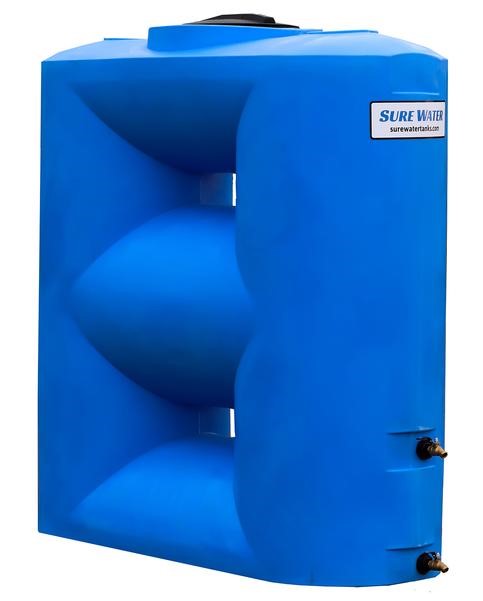
Plastic water barrels
Plastic containers usually consist of polyethylene-based plastics, or plastics #1, #2, and #4. The best are made of food-grade high-density polyethylene (HDPE) #2. High-density polyethylene has high tensile strength, is resistant to many common solvents, and is BPA free. Linear low-density polyethylene (LLDPE) #4 is also commonly used for water storage. Food-grade polyethylene containers should be dark in color to block UV light, which can cause microorganisms to grow.
Unlike their metal counterparts, plastic water containers are lighter and easier to move. Plastic containers can be cleaned with diluted bleach or some dish soap and rinsed out before use. When properly stored, food-grade polyethylene-based plastics last a long time.
The plastic itself allows for flexibility in design. Some plastic containers like the Augason Farms 55 Gallon Water Barrel are just simple drums that have a cap on the top of the barrel. Others like the Smart Tank 50 Gallon Stackable Water Storage Tank are molded so that they can stack on top of each other for efficient storage.
Premium tanks like the STORMTANKER 185 gallon water tank are designed to resist bulging and feature upper and lower valves that allow for filling a secondary container or rotating water.
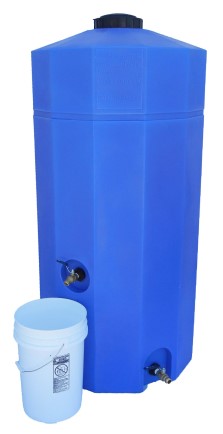
What about metal barrels?
Large metal storage containers do exist, like those from Skolnik Industries, but they are roughly ten times the cost of a plastic container and can be extremely heavy. If you want to store water in a metal container, use food-grade 304 or 316 stainless steel. Stainless steel will last a long time, but when compared to food-grade plastic, it’s heavy, cumbersome, and not practical.
What about rain barrels?
Rain barrels like the RTS Home Accents 50-Gallon Rain Water Collection Barrel are made of food-grade high-density polyethylene, and come in 50 gallon sizes. The water in rain barrels will be contaminated, and you should plan on filtering and chemically treating before use. In the event that SHTF, rain barrels may draw negative attention.
A lot of barrels marketed as rain barrels are made of recycled high-density polyethylene. Look for virgin food-grade polyethylene. Any of our 50 or 55 gallon picks, like the Augason Farms 55 Gallon Water Barrel, or Smart Tank 50 Gallon Stackable Water Storage Tank will work just fine as a rain barrel.
